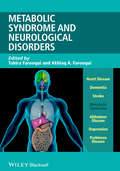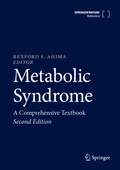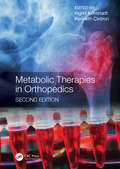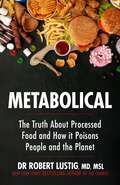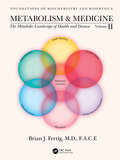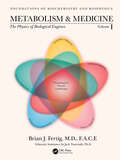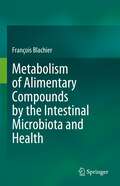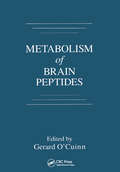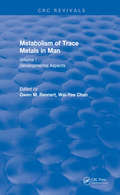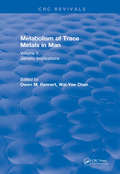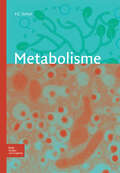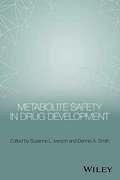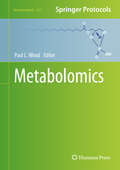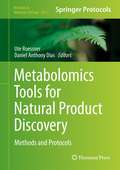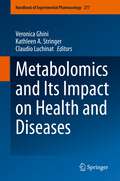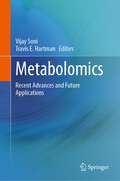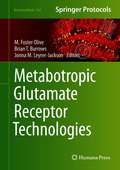- Table View
- List View
Metabolic Syndrome and Complications of Pregnancy
by Barry Sears Enrico FerrazziThis book explores the nature of pregnancy and metabolic syndrome as proinflammatory conditions and explains how pregnancy provides a window of opportunity for preventing the lifelong complications of metabolic syndrome, during which key risk factors can be identified and beneficial dietary changes can be implemented. The book's opening sections discuss inflammation in the context of pregnancy, including the nature of the placenta as a proinflammatory tissue. In the main body, it points to new possible connections to truncal obesity, inflammation, metabolic syndrome, and major obstetrical syndromes, including preeclampsia, gestational diabetes and pre-term delivery. Based on the insights offered by this analysis, the remainder of the book focuses on a variety of nutritional measures and diets that can be of benefit during and beyond pregnancy. Readers will learn how the higher level of compliance with medical instructions during pregnancy can be capitalized on to ensure enduring health benefits for mother and child alike.
Metabolic Syndrome and Diabetes
by Marina Kurian Bruce M. Wolfe Sayeed IkramuddinThis book provides a concise, state-of-the art review of the surgical treatment of metabolic syndrome and diabetes mellitus. The volume reviews what current practices in surgery and metabolic syndrome and diabetes including the biohormonal effects of the different surgeries. Isolating the effects of the different procedures is critical to the decision tree for type of procedure selected for an individual patient. Specifically for diabetes, this textbook will provide a guide for practitioners to a tailored approach to the treatment. Areas of ongoing research that highlight the minimally invasive approach as well as incorporating what we know of the biochemical results of surgery are presented. Results of established weight loss procedures and ongoing trials are juxtaposed against some of the more novel techniques to ascertain a best practice. Metabolic Surgery and the Surgical Treatment of Diabetes serves as a very useful resource for physicians and researchers dealing with, and interested in, this rising epidemic of metabolic syndrome and diabetes. It provides a concise yet comprehensive summary of the current status of the field that will help guide patient management and stimulate investigative efforts.
Metabolic Syndrome and Neurological Disorders
by Akhlaq A. Farooqui Tahira FarooquiMetabolic Syndrome and Neurological Disorders brings together information on the cluster of common pathologies which cause metabolic syndrome - abdominal obesity linked to an excess of visceral fat, insulin resistance, dyslipidemia and hypertension - to provide a comprehensive and cutting edge exploration of the link between metabolic syndrome and neurological disorders. Metabolic syndrome is recognized to play a role in neurological disorders such as stroke, Alzheimer's disease, and depression. For the first time in book form, Metabolic Syndrome and Neurological Disorders covers the molecular mechanisms thought to underlie this mirror relationship, as well as how lifestyle and other factors such as oxidative stress and inflammation may play a role in the disease. Grounded in a series of epidemiological studies of metabolic-cognitive syndrome, this book will be a valuable reference for researchers, dietitians, nutritionists, and physicians.
Metabolic Syndrome: A Comprehensive Textbook
by Rexford S. AhimaThis comprehensive reference work presents an up-to-date survey of the current scientific understanding of the metabolic syndrome, as well as an overview of the most significant advances in the field. The book offers a thorough reference for obesity and the metabolic syndrome and will prove an indispensable resource for clinicians, researchers and students. The obesity epidemic has generated immense interest in recent years due to the wide-ranging and significant adverse health and economic consequences that surround the problem. Much attention has been focused on excessive consumption of energy-dense food, sedentary lifestyle, and other behaviors that contribute to the pathogenesis of obesity. However, obesity is a highly complex condition that is influenced by genetic as well as environmental factors. The metabolic syndrome comprises of central obesity, hyperglycemia, hypertension, and dsylipidemia. The incidence of metabolic syndrome is growing worldwide, affecting more than one-third of adults in some countries. The metabolic syndrome increases the risk of developing coronary artery disease and stroke, and it is closely associated with fatty liver, dementia, cancer, sleep apnea, kidney failure, and other diseases. This reference work covers the full range of scientific and clinical aspects of obesity and metabolic syndrome: epidemiology, genetics, environmental factors, pathophysiology, diseases associated with obesity, pediatric obesity, and clinical management.
Metabolic Therapies in Orthopedics, Second Edition
by Ingrid Kohlstadt Kenneth CintronThe first medical reference textbook to compile an unprecedented synthesis of evidence for regenerative orthopedics by key opinion leaders Thirty-five authors address your clinical questions What emerging technologies are right for my clinical practice? How can I strengthen my patients before their orthopedic surgery? Practically speaking, how can I leverage the latest metabolic therapies to safeguard my patients from toxins, medications, food and chronic diseases known to adversely affect the musculoskeletal system? "Ask the Author" feature Would you like to discuss a patient with a particular author? Now you can do so at www.betterorthopedics.com. First to be second Did you notice this book is the first book in regenerative orthopedics to publish a second edition? This diverse author team leads the growing field of regenerative orthopedics and offers the broadest and in-depth approach to leveraging metabolic therapies. This book comprises the professional opinion of its authors. It does not claim to represent guidelines, recommendations, or the current standard of medical care.
Metabolical: The truth about processed food and how it poisons people and the planet
by Dr Robert LustigDid you know that 62% of the food in our supermarkets is not only processed but 'ultra-processed' (ingredients from other foods are combined to make something 'new', often in colours that do not exist in nature) and that data shows that by eating this kind of food over time we are literally slowly poisoning ourselves?In the hard-hitting, ground-breaking tradition of his NY Times bestseller FAT CHANCE, which revealed the dangers of sugar, Dr Robert Lustig persuasively presents a stark exposé of how our addiction to processed foods (aided and abetted by the food industry, big ag, big pharma, institutional medicine and the government) is behind the lethal increase in major non-communicable diseases, including diabetes, heart disease, fatty liver disease, cancer and dementia. We have come to accept that these chronic diseases are simply part of the 'natural ageing process', but Dr Lustig makes the case that this is simply not true. The solution on both a personal and societal level is a return to unprocessed food and Dr Lustig offers a doable plan for us to heal and restore our own health and wellbeing with real food, and in the process boosting our immunity to viruses like Covid-19.'Metabolical lays bare the depth of the relationship between the recent and profound perversion of the human diet and its overwhelming health consequences.' Dr David Perlmutter, author of the #1 New York Times bestsellers Grain Brain and Brain Wash
Metabolical: The truth about processed food and how it poisons people and the planet
by Dr Robert LustigIt's not what you eat that's damaging your health it's how that food is 'made'. The truth behind ultra-processed food that the food industry doesn't want you to know.Did you know that 62% of the food in our supermarkets is not only processed but 'ultra-processed' (ingredients from other foods are combined to make something 'new', often in colours that do not exist in nature) and that data shows that by eating this kind of food over time we are literally slowly poisoning ourselves?In the hard-hitting, ground-breaking tradition of his NY Times bestseller FAT CHANCE, which revealed the dangers of sugar, Dr Robert Lustig persuasively presents a stark exposé of how our addiction to processed foods (aided and abetted by the food industry, big ag, big pharma, institutional medicine and the government) is behind the lethal increase in major non-communicable diseases, including diabetes, heart disease, fatty liver disease, cancer and dementia. We have come to accept that these chronic diseases are simply part of the 'natural ageing process', but Dr Lustig makes the case that this is simply not true. The solution on both a personal and societal level is a return to unprocessed food and Dr Lustig offers a doable plan for us to heal and restore our own health and wellbeing with real food, and in the process boosting our immunity to viruses like Covid-19.(P) 2021 HarperCollins Publishers
Metabolism and Epigenetic Regulation: Implications in Cancer (Subcellular Biochemistry #100)
by Tapas Kumar Kundu Chandrima DasMetabolic programs of individuals are key determinants for disease susceptibility and immune response. This book, edited by experts in the field, summarizes epigenetic signaling pathways that regulate metabolic programs associated with cancer and cancer-related secondary diseases.The first part of the book highlights key metabolic pathways that are implicated in cancer and provides a comprehensive overview on the carbohydrate, protein, lipid, amino- and nucleic acid metabolic pathways that are deregulated in cancer. Special attention is paid to the altered tumor micro-environment that is influenced by the metabolic milieu. Furthermore, the fundamental relationship between the cellular metabolic environment and cell death-mediated autophagy is discussed.The second part of the book covers our understanding of the fundamental epigenetic regulations that are implicated in controlling the metabolic programs in cancer cells. Many aspects of epigenetic regulation of non-coding RNAs as well as DNA/RNA methylation, which influencing metabolic homeostasis in cancer, are discussed in detail. Special emphasis is placed on the epigenetic regulation of the amino acid, glucose/carbohydrate metabolism and epigenetic regulation during hypoxia and its connection to cancer.Last but not least, the third part of the book covers small molecule modulators of histone modifying enzymes, which can be used as therapeutic tools. The readers learn about the cross-talk between epigenetics and immunometabolims, as well as the epigenetic regulation of oncometabolites to combat cancer. Given its scope, the book will appeal to a broad readership interested in epigenetic, cancer and metabolic research.
Metabolism and Medicine: The Metabolic Landscape of Health and Disease (Volume 2) (Foundations of Biochemistry and Biophysics)
by Brian FertigChronic disease states of aging should be viewed through the prism of metabolism and biophysical processes at all levels of physiological organization present in the human body. This book connects these insights to what causes them to go awry in the context of unhealthy human behaviors and aging, aiming to buttress scientific creativity. It also provides links between the art and science of medicine that strengthens problem-solving in patient care. New and important discoveries in the area of metabolic health and metabolic diseases are discussed in exquisite detail. Key Features: Broad and up-to-date overview of the field of metabolic aspects of health and chronic disease development, especially connecting the spectrum of topics that range from molecular clocks to stress response to nuclear hormone receptors and the role of microbiota in human health Provides a deeper basic science and interdisciplinary understanding of biological systems that broaden the perspectives and therapeutic problem solving by elaborating on the usefulness of the Physiological Fitness Landscape Describes the importance of insulin resistance in metabolic disease, especially diabetes but also includes links to cancer and Alzheimer’s disease Examines the process of aging from the perspective of metabolic decline illustrating it with the Physiological Fitness Landscape This book, the second volume in a two-volume set, primarily targets an audience of clinical and science students, biomedical researchers and physicians who would benefit from understanding each other’s language.
Metabolism and Medicine: The Physics of Biological Engines (Volume 1) (Foundations of Biochemistry and Biophysics)
by Brian FertigChronic disease states of aging should be viewed through the prism of metabolism and biophysical processes at all levels of physiological organization present in the human body. This book describes the building blocks of understanding from a reasonable but not high-level technical language viewpoint, employing the perspective of a clinical physician. It brings together concepts from five specific branches of physics relevant to biology and medicine, namely, biophysics, classical electromagnetism, thermodynamics, systems biology and quantum mechanics. Key Features: Broad and up-to-date overview of the field of metabolism, especially connecting the spectrum of topics that range from modern physical underpinnings with cell biology to clinical practice. Provides a deeper basic science and interdisciplinary understanding of biological systems that broaden the perspectives and therapeutic problem solving. Introduces the concept of the Physiological Fitness Landscape, which is inspired by the physics of phase transitions This first volume in a two-volume set, primarily targets an audience of clinical and science students, biomedical researchers and physicians who would benefit from understanding each other’s language.
Metabolism of Alimentary Compounds by the Intestinal Microbiota and Health
by François BlachierThis book provides an overview of the metabolism of dietary compounds by the intestinal microbiota, and on the consequences of such metabolic activity on host metabolism and physiological functions; both in intestinal and peripheral tissues.Over the last years, our understanding of the causal links between microbiota metabolic activity towards dietary and endogenous substrates and human health status has evolved extensively. In this context, the book starts with a comprehensive introduction devoted to the physiological and metabolic functions of the intestinal epithelium, followed by a part dedicated to the way intestine offers board and lodging for microbes being on a short- or long-term stay. The next chapters focus on the utilization of the available substrates from diet by the intestinal bacteria to produce numerous bacterial metabolites, and on the impact of such microbial activity, in the first place for communication between microbes, and for communication between microbes and lodging host. As will be detailed, this latter process of interkingdom communication leads to either beneficial or deleterious effects on intestinal physiology and metabolism. Special attention is given to selected pathophysiological processes namely chronic intestinal inflammation, colorectal carcinogenesis, and diarrhea. Then, the effects of modifications of bacterial metabolites and other bioactive compounds by the host after intestinal absorption, and consequences for peripheral tissue functions are presented.Summarizing the state of the art on what is known about the metabolic crosstalk between gut microbiota and human metabolism, as well as perspectives for further experimental and clinical research, this book provides a useful resource for researchers, professionals, and students with a background in biology, and/or nutrition, medicine, pharmacology, and for those which are involved in the agriculture and food production. By explaining technical terms all along the text, this book should be understandable also for interested non-specialists.
Metabolism of Anabolic-Androgenic Steroids
by Victor A. RogozkinThis book presents an authoritative review of the research regarding the influences of anabolic-androgenic steroids on metabolism. The book provides a concise description of the biochemistry of these steroids using simple terms and includes methods of separation and their clinical applications. The first section of the book examines the general structure, nomenclature, and classification of anabolic-androgenic steroids. Subsequent chapters explore concepts basic to understanding the pathways of their metabolism in both target and non-target tissues, including the interactions of steroids with receptors and the effects of steroids on the cellular metabolism of skeletal muscle. The changes and molecular base of modifications in metabolism during exercise involving anabolic-androgenic steroids are also described. Finally, a comprehensive review of methods for scanning and identifying anabolic-androgenic steroids in biological fluids is presented, as well as a discussion regarding the applicability and limitations of these techniques. The book provides valuable reference information for all scientists and clinicians engaged in sports medicine, exercise biochemistry, and endocrinology.
Metabolism of Brain Peptides
by Gerard O'CuinnMetabolism of Brain Peptides discusses neuropeptide metabolism in light of recent research. It describes the processing mechanisms in the production of biologically active peptides. It details distribution of the variety of neuropeptides in the brain and comprehensively reviews the effects of these neuropeptides on behavioral and physiological functions. The book also examines termination mechanisms for the biological activities of neuropeptides in light of recent knowledge of their distribution, their receptors and their possible inactivation enzymes in various functional regions of the brain and at the blood-brain barrier.
Metabolism of Drugs and Other Xenobiotics
by Pavel Anzenbacher Ulrich M. ZangerA practice-oriented desktop reference for medical professionals, toxicologists and pharmaceutical researchers, this handbook providessystematic coverage of the metabolic pathways of all major classes of xenobiotics in the human body. The first part comprehensively reviewsthe main enzyme systems involved in biotransformation and how they are orchestrated in the body, while parts two to four cover the threemain classes of xenobiotics: drugs, natural products, environmental pollutants. The part on drugs includes more than 300 substances fromfive major therapeutic groups (central nervous system, cardiovascular system, cancer, infection, and pain) as well as most drugs of abuseincluding nicotine, alcohol and "designer" drugs. Selected, well-documented case studies from the most important xenobiotics classes illustrate general principles of metabolism, making this equally useful for teaching courses on pharmacology, drug metabolism or moleculartoxicology.Of particular interest, and unique to this volume is the inclusion of a wide range of additional xenobiotic compounds, including food supplements, herbal preparations, and agrochemicals.
Metabolism of Human Diseases
by Eckhard Lammert Martin Zeeb"Metabolism of Human Diseases" examines the physiology of key organs (e. g. brain, eye, lung, heart, blood vessels, blood, immune system, gastrointestinal tract, pancreas, liver, fat tissue, kidney, reproductive system, teeth, bone and joints) and how defective metabolism and signaling pathways within these organs contribute to common human diseases. The latter include depression, schizophrenia, epilepsy, Parkinson's disease, Alzheimer's disease, migraine, multiple sclerosis, Down syndrome, macular degeneration, glaucoma, asthma, COPD, pneumonia, atherosclerotic heart disease, heart failure, stroke, varicose veins, Sickle cell disease, hyperlipidemia, fever, sepsis, allergies, peptic ulcer, gastroenteritis, lactose intolerance, colon cancer, diabetes, cirrhosis, metabolic syndrome, hypertension, chronic kidney disease, gout, urinary tract infections, kidney stones, dental caries, osteoporosis, osteoarthritis, rheumatoid arthritis, breast cancer and prostate cancer. The book also describes commonly used drugs and explains their molecular targets. It provides the first comprehensive and detailed summary of the metabolism of individual organs and their physiological and pathological functioning. Thus it serves as a useful supplement to previous textbooks of human physiology "Metabolism of Human Diseases" is a must-have, state-of-the-art textbook written by International experts for graduate students, postdocs and scientists in metabolic research, biochemistry, physiology and pharmacy as well as for physicians interested in molecular mechanisms underlying common human diseases.
Metabolism of Trace Metals in Man Vol. I: Developmental Aspects (CRC Press Revivals)
by Wai-Yee Chan Owen M. RennertA vast literature exists dealing with trace metals and a number of outstanding monographs deal with the biological, biochemical, or clinical effects of a specific trace metal or trace metals in general. However, newer aspects of trace metal research, i.e. the developmental aspects and generic implications, have not been systematically discussed in any existing texts. The present two volumes will summarize the present status of research in these areas and serve as milestones for future development in these areas of trace metal research.
Metabolism of Trace Metals in Man Vol. II: Genetic Implications (CRC Press Revivals)
by Owen M. Rennert and Wai-Yee ChanA vast literature exists dealing with trace metals and a number of outstanding monographs deal with the biological, biochemical, or clinical effects of a specific trace metal or trace metals in general. However, newer aspects of trace metal research, i.e. the developmental aspects and generic implications, have not been systematically discussed in any existing texts. The present two volumes will summarize the present status of research in these areas and serve as milestones for future development in these areas of trace metal research.
Metabolisme
by Frans C. SchuitHet metabolisme ofwel de stofwisseling van de mens is een complex chemisch proces dat van invloed is op veel facetten van gezondheid en ziekte. Het vormt dan ook een onmisbaar onderwerp in opleidingen als geneeskunde, biomedische wetenschappen, farmacie en mondzorg. Studenten en docenten hebben lange tijd moeten putten uit een geringe keus aan duidelijk medische georiënteerde leerboeken over het menselijke metabolisme. Dit boek vormt een welkome aanvulling op dit titelaanbod. Metabolisme bestaat uit twaalf hoofdstukken, verdeeld over twee lagen. De eerste laag biedt de student de kernleerstof en wordt ondersteund door 260 afbeeldingen, concrete leerdoelen en studeeraanwijzingen. De tweede laag gaat nader in op bepaalde onderwerpen en tast hierbij de grenzen van wetenschappelijk verantwoorde vakkennis over het menselijk metabolisme af, bespreekt de rol van pioniers in vroeger onderzoek, benoemt het belang hiervan voor huidige medische toepassingen en beschouwt het onderwerp voorts vanuit de evolutieleer. Deze verdieping in de stof is herkenbaar gemaakt in vier thema’s en met ruim 600 verwijzingen naar recente wetenschappelijke literatuur.De veelzijdige samenstelling van deze tweede informatielaag biedt studenten de mogelijkheid een leerpad te volgen dat bij de eigen interesses aansluit. Door deze opzet fungeert het boek als een handige leidraad voor studenten aan alle bovengenoemde opleidingen. Zo dient Metabolisme als gids tijdens een reis op weg naar onafhankelijk en kritisch nadenken over een complex proces.
Metabolite Safety in Drug Development
by Dennis A. Smith Suzanne L. IversonA reference on drug metabolism and metabolite safety in the development phase, this book reviews the analytical techniques and experimental designs critical for metabolite studies. It features case studies of lessons learned and real world examples, along with regulatory perspectives from the US FDA and EMA.* Reviews the analytical techniques and experimental designs critical for metabolite studies* Covers methods including chirality, species differences, mass spectrometry, radiolabels, and in vitro / in vivo correlation* Discusses target pharmacology, in vitro systems aligned to toxicity tests, and drug-drug interactions* Includes perspectives from authors with firsthand involvement in industry and the study of drug metabolites, including viewpoints that have influenced regulatory guidelines
Metabolomics (Neuromethods #159)
by Paul L. WoodThis volume discusses the latest analytical approaches used to sample defined molecular populations of metabolites via functional group derivatization, specialized chromatographic methods, and ionization techniques. Chapters cover key methods for sample introductions to the ion source, including direct flow, gas chromatography, liquid chromatography, and capillary electrophoresis. Chapters also explore non-targeted and targeted analyses, as well as the emerging field of metallomics. In the Neuromethods series style, chapters include the kind of detail and key advice from the specialists needed to get successful results in your laboratory. Cutting-edge and authoritative, Metabolomics is a valuable resource for students, researchers, practicing physicians and veterinarians, and administrators involved in the funding of research.
Metabolomics Tools for Natural Product Discovery: Methods and Protocols
by Daniel Anthony Dias Ute RoessnerClassical natural product chemistry is transitioning to modern day metabolomics as a result of the advent of comprehensive analytical platforms and sensitive analytical instrumentation. Therefore, it is worthwhile to summarize recent developments with current analytical platforms and highlight how metabolomics is being integrated into this classical field to dereplicate and profile natural product extracts. Metabolomics Tools for Natural Product Discoveries: Methods and Protocols aims to unite diverse and recently developed methodologies and protocols in order to identify bioactive secondary metabolites for the purpose of drug discovery. Some topics covered in this volume include applications for the extraction of selected natural products from less common sources such as bryophytes and hard corals, various biological assays, comprehensive applications and strategies for GC-MS, LC-MS, and NMR, as well as protocols and strategies for the structure elucidation of isolated natural products. Written in the successful Methods in Molecular Biology series format, chapters include introductions to their respective topics, lists of the necessary materials and reagents, step-by-step, readily reproducible protocols, and notes on troubleshooting and avoiding known pitfalls. Authoritative and easily accessible Metabolomics Tools for Natural Product Discoveries: Methods and Protocols seeks to serve both professionals and research students with its well-honed methodologies for natural product isolation, biomarker discovery, dereplication, biological assays, and comprehensive metabolomic platforms available for high-throughput analyses.
Metabolomics and Its Impact on Health and Diseases (Handbook of Experimental Pharmacology #277)
by Veronica Ghini Kathleen A. Stringer Claudio LuchinatThis volume of the Handbook of Experimental Pharmacology, which celebrated its 100th anniversary in 2019, addresses the rapidly growing and evolving field of metabolomics. It has been compiled and designed to broaden and enrich your understanding as well as simplify a complicated picture of the diverse field of metabolomics. This is accomplished by chapters from experts in the field on basic principles as well as reviews and updates of analytical techniques. The variety and different perspectives of the NMR approaches are described in the chapters By David Wishart, Daniel Raftery and Ryan McKay, while mass spectrometry advances are covered by Charles R. Evans and Stefan Kempa. This book also reflects the state of the art in the application of metabolomics to cell biology (Marta Cascante and Ulrich Guenther) and chapters that share insights into the application of metabolomics in various diseases (Paola Turano and Claudio Luchinat, Rachel S. Kelly and Jessica Lasky-Su, Paige Lacy, and Angela Rogers. Relationships of metabolomics with drugs are highlighted by Robert Verpoorte (natural products drug discovery), by Oscar Millet and by Turano and Luchinat (perspectives in precision medicine) and by Daniel L. Hertz (drug-induced peripheral neuropathy). From the above list of diverse topics, we believe this book has interdisciplinary appeal and scholars with an interest in the role of metabolomics in achieving precision medicine will find it of particular or special interest.
Metabolomics: Recent Advances and Future Applications
by Vijay Soni Travis E. HartmanThis book Introduces the extensive applications of metabolomics from all possible areas of research and development so that not only an undergraduate can understand the advancement of metabolomics, but an entrepreneur can harness the knowledge to address possible problems to make a perfect tool to address their research question. Topics covered include the role of metabolomics in the development of agriculture, plant pathology, and their applications; the generalized application of the metabolomics and use of related technologies in various sectors of industries; and the future of metabolomics and upcoming related technologies that can fill the gap between different -omics and their applications for the betterment of humankind. This is an ideal book for university professors, researchers, and advanced-level scientists who are exploring different avenues in metabolomics. Availability of this concise information in one place will aid scientists by expanding their arsenal of techniques and can be helpful to bring more collaborations and to identify the expert at the global level.
Metabotropic GPCRs: TGR5 and P2Y Receptors in Health and Diseases
by Senthilkumar Rajagopal Murugavel PonnusamyThis book will provide current understandings about two ubiquitously expressed metabotropic GPCRs, G-coupled purinoreceptor type 2 (P2Y) and Takeda G-protein-coupled bile acid receptor 5 (TGR5). G protein coupled receptors (GPCRs) are the largest family of proteins implicated in majority of cellular responses. The two receptor sub-families play a central role in many physiological functions as well as in many pathological conditions. This book offers up-to-date information on the physiological functions, signaling pathways and regulatory mechanisms of P2Y and TGR5 receptors. In addition, this book provides a comprehensive overview about the abnormalities of P2Y/TGR5 receptors and their contribution in the development and progression of pathological conditions. It also covers the currently available natural, chemical and pharmacological agents targeting these two receptor families and their therapeutic implications in P2Y and TGR5 associated disorders. This book is a valuable source for beginners and researchers to follow the rapidly progressing field of these two GPCR subfamily members.
Metabotropic Glutamate Receptor Technologies (Neuromethods #164)
by M. Foster Olive Brian T. Burrows Jonna M. Leyrer-JacksonThis volume highlights various techniques used to study multiple aspects of mGlu receptor function. Chapters in this book cover topics such as modern approaches for the development and screening of allosteric modulators; fluctuations in intracellular calcium induced by mGlu receptor activation; dopamine-glutamate interactions in the central nervous system; methods for assessing mGlu receptor localization; and common techniques for evaluating mGlu modulation in behavior in rodents, including stress and alcohol drinking. In the Neuromethods series style, chapters include the kind of detail and key advice from the specialists needed to get successful results in your laboratory.Cutting-edge and practical, Metabotropic Glutamate Receptor Technologies provides researchers with a starting point to address important questions regarding mGlu and its importance. Researchers working in the fields of neuroscience and physiology of multiple peripheral systems will find this volume most useful.


